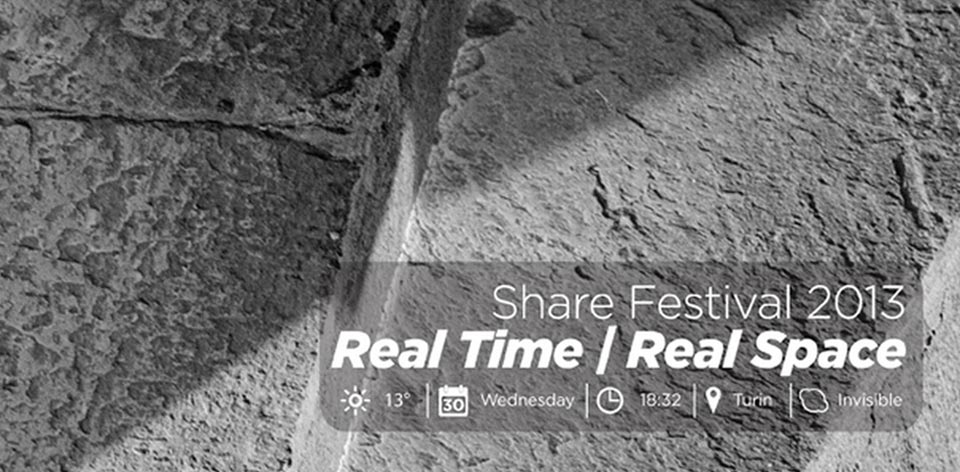
OPENING
30th October, 6.30 p.m.
Albertina Academy of Fine Arts of Turin – via Accademia Albertina 6, Turin
From 30th October to 16th November, we’ll be teaming up once again with the Regional Museum of Natural Science in Turin and together will be presenting the festival at the Albertina Academy of Fine Arts.
Real Time | Real Space is the title of the 9th Share Festival.
With the virtual reality binge of the Nineties now just a drunken memory, the immaterial has gravitated back down to earth, cloaking us like an interactive veil. The Internet of Things has become a consolidated reality, a business that will be worth almost US $2 trillion by 2020, when it is predicted some 30 billion mobile devices will be linked up (from 3.5 billion today).
So in succumbing to gravity, it has also acquired some of its own—in a physical sense in terms of its integration with people and places, but also in terms of being too important to be underestimated.
While, “In a world of digital dignity, each individual will be the commercial owner of any data that can be measured from that person’s state or behavior,” today this not the case. Gartner, a research firm, predicts that by 2017 eight out of every ten people will collect, track and barter their personal information for cost savings.
From the information highways to social networks, content is produced through the perpetual, instant remixing of information.
Such instant interactive data mining will raise the value of personal information, but at what cost to the concept of privacy?
The digital veil has given rise to code/spaces that are the product of coded infrastructures, where production processes are stretched out across network architectures, making them simultaneously local and global, grounded in certain locations, but accessible from anywhere.
How have artists reacted to the space that emerges through a contingent, relational and context-dependent practice?
Distributed computing has changed our approach to technology. It is “no longer object centered, resolutely personal, individually framed and of the order of conscious perception,” but rather perception is, in these environments, “atmospheric, impersonal, collectively accessible, and microtemporal in its sensory address.”
As Eric Kluitenberg points out, there has been a resurgence of social protests in an era of ubiquitous social media. By physically gathering together on streets and squares, individuals have become a crowd, transformed into a “public” that can raise its voice through the visibility gained through the re-appropriation of public space.
Private identities and profiles are being cast aside in favour of the creation of public roles, reflecting a shift in the balance of power from the individual to the environment, to the system, to the infrastructure, and to the network.
Distributed knowledge does not just represent a new stage in computer evolution, but a qualitative leap in our perception of reality.
In a REAL TIME | REAL SPACE world, computers interact with us at the microsensory and microtemporal levels, which are invisible to conscious perception. Mediation is achieved through forms of virtual assistants or artificial intelligence systems that undermine a Cartesian egocentric approach in favour of incorporating the mind and body in the world.
Looking at our relationship with this mixed reality, where we can move instantly from one location to another, from one network to the next, Marleen Stikker highlights how the blinking cursor is no longer outside us—we are the cursor.
How does the way humans interact with society change when we become a “cursor”? What local variations arise when a technology meets a specific cultural context?
This veil that cloaks reality can be used—like any veil—to both hide and reveal, depending on our intentions and our approach to the huge pile of data that we have at our disposal today. The Density Design lab in Milan, for example, aims to give humans new tools for rationalizing the use of data through visual representation.
This year’s Share Festival looks at what artists are making of all this, as they work in a context where they are also social commentators and activists, who use networks to redefine relational and media space.
What social, artistic and cultural practices can help build a pluralist society made up of aware people and users? What practices are artists using to promote an open, inclusive society?
REAL TIME | REAL SPACE explores these threads, presenting temporary solutions that point the way to how art can re-direct the processes shaping artists, networks, and the community.